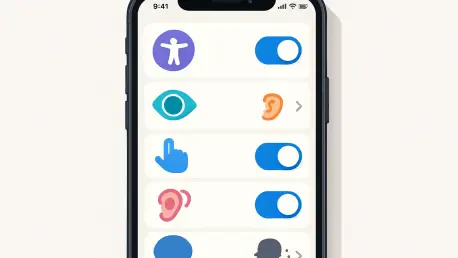I’m thrilled to sit down with Vijay Raina, a seasoned expert in enterprise SaaS technology and software design, who brings a wealth of knowledge in crafting accessible iOS applications. With a deep understanding of how inclusive design can elevate user experiences, Vijay has been at the forefront of integrating accessibility into software architecture. In this interview, we dive into the importance of accessibility in iOS app development, exploring practical strategies for implementation, the impact on diverse user groups, and how these practices shape better coding habits. Join us as we uncover actionable insights and inspiring perspectives on creating apps that truly work for everyone.
How did you first become passionate about accessibility in iOS app development, and what drives you to prioritize it in your work?
I’ve always believed that technology should empower everyone, not just a select few. My passion for accessibility sparked early in my career when I worked on a project for a public institution and saw firsthand how many users struggled with basic interactions due to overlooked design choices. It hit me that neglecting accessibility excludes a huge portion of potential users—around 15% of the global population lives with some form of disability. What drives me now is the challenge and reward of building solutions that are inclusive. It’s not just about compliance; it’s about crafting experiences that feel seamless and intuitive for all, which ultimately makes me a better developer and thinker.
Why do you think accessibility is a critical aspect of app development, beyond just helping users with disabilities?
Accessibility isn’t a niche concern—it’s a cornerstone of good design. When you build with accessibility in mind, you’re not only supporting users with disabilities but also enhancing the experience for everyone. Take larger fonts or simplified navigation; these features help people in temporary situations, like reading in bright sunlight or using a device one-handed while holding a coffee. Plus, there are legal imperatives in sectors like healthcare or education where accessibility is mandatory. Beyond that, it’s smart business—reaching more users means a broader impact. It’s about creating a product that’s universally usable, and that’s a win for any developer or company.
Can you walk us through what VoiceOver is and how you approach implementing it to make an app more inclusive?
VoiceOver is iOS’s built-in screen reader that narrates the interface for users who are blind or have low vision, allowing them to interact with apps through gestures and audio feedback. When I implement it, I focus on making every meaningful element speakable and clear. For instance, on a button, I set properties like accessibilityLabel for a concise description—say, “Play”—and accessibilityHint to guide action, like “Double tap to start playback.” I also use accessibilityTraits to define the element’s role, ensuring VoiceOver doesn’t redundantly announce something obvious. My approach is to test early and often, navigating the app myself with VoiceOver on to catch any awkward or unclear feedback, ensuring users get a fluid experience.
What’s your process for supporting Dynamic Type, and how do you handle challenges when text sizes drastically change?
Dynamic Type lets users adjust text size system-wide, which is crucial for readability, especially for those with vision impairments. My process starts with using UIFont.preferredFont(forTextStyle:) instead of hardcoding font sizes, so text scales based on user settings. I also set adjustsFontForContentSizeCategory to true on labels to ensure they adapt automatically. The challenge comes when text grows significantly—layouts can break or overlap. To handle this, I prioritize flexible constraints in Auto Layout, allowing for text wrapping and dynamic view heights. I’ve had cases where a button label pushed elements off-screen at larger sizes, so I adjusted the layout to stack elements vertically instead. Testing across size categories in the simulator helps me spot and fix these issues before they reach users.
How do you adapt your app’s design for users who enable the Reduce Motion setting, and why does this matter?
Reduce Motion is an iOS setting that minimizes animations for users who experience motion sickness or discomfort from excessive movement on screen. I check if it’s enabled using UIAccessibility.isReduceMotionEnabled and then tone down or replace animations with static transitions. For example, instead of a sliding menu animation, I might just fade it in. This matters because respecting user preferences isn’t just courteous—it’s essential for comfort and usability. Some users can feel physically ill from intense animations, and ignoring that can make your app unusable for them. It’s a small adjustment on my end that makes a huge difference in their experience.
In what ways has working on accessibility features influenced your overall approach to coding and software design?
Working on accessibility has fundamentally improved how I code. It forces me to think about separation of concerns—like keeping UI logic clean and reusable—which makes my codebase more maintainable. Setting clear accessibility labels pushes me to name elements meaningfully, improving readability for myself and my team. It also encourages scalable design; for instance, using semantic colors like UIColor.label for contrast settings ensures my app adapts to system themes effortlessly. Above all, it’s taught me to empathize with diverse user needs, which shapes every decision I make, from layout to feature prioritization. Accessibility isn’t an add-on; it’s a lens that sharpens my entire development process.
What’s your forecast for the future of accessibility in iOS app development, and where do you see it heading in the next few years?
I’m optimistic about the future of accessibility in iOS development. Apple has consistently pushed the envelope with tools like VoiceOver and Dynamic Type, and I expect even deeper integration of machine learning to personalize user experiences—like predictive text sizing or adaptive interfaces based on usage patterns. I also see a growing emphasis on developer education; frameworks like SwiftUI are making accessibility more intuitive to implement from the ground up. In the next few years, I predict accessibility will become a non-negotiable standard, not just due to legal mandates but because users will demand it. As awareness grows, apps that ignore inclusivity will simply fall behind, and I’m excited to see how this shapes a more equitable digital landscape.









